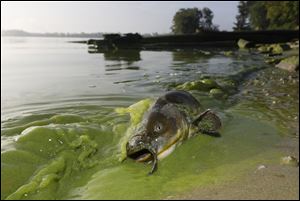
The threat is now for Lake Erie
9/25/2017
Many fish will perish in the algae-filled waters of Lake Erie.
It is possible to think of toxic green algae and the dangerous microcystin it produces as abstract and far-away. The water coming out of our Toledo-area taps looks fine.
But, last week, the algae that threatens our health, our economy, and our quality of life in Toledo moved up the river. We can no longer live in a state of detachment or denial.
Look no further than the gape-mouth, algae-covered, dying fish photographed by The Blade’s Andy Morrison for concrete evidence of the seriousness of the problem.
Click here to read more Blade editorials
How many wake-up calls do we need?
The microcystin in the lake is once again threatening the city’s only water-system intake. And the toxin levels at Maumee Bay State Park are now more than 10 times higher than the safe threshold for swimming and other direct human contact.
Is it rational, in light of all that, to continue to dither over the impairment designation?
We need leadership on this issue. The mayor doesn’t get it. The governor does not seem to care. Our congressman’s pleas have fallen on deaf ears. It is time for our two U.S. senators to ramp up their efforts and light a fire at the U.S. Environmental Protection Agency. They must go to bat for Lake Erie and Greater Toledo and make this issue their No. 1 concern.
The EPA has released the overview of its domestic action plan for addressing the environmental threat to the lake. It reaffirms the goal of a 40-percent reduction in algae-feeding phosphorus flowing into the lake by 2025.
That doesn’t cut it.
Even if voluntary measures by agriculture, other industries, and communities with combined-sewer overflow problems can somehow meet that 40-percent reduction goal, there will still be 7.3 million pounds of phosphorus flowing into Lake Erie each year.
Harmful algae blooms are a direct threat to Toledo’s drinking water supply. With just one intake in the lake, Toledo’s 2014 water crisis should have been the wake-up call to get serious about preventing algae blooms and building a second intake to preserve access to clean water for the city’s 500,000 water customers. But we still seem to be asleep.
How bad does it need to get? How dire must the wake-up calls be? Are we waiting for pictures of poisoned children, as in Flint?
Yet when one of the lake’s most dedicated defenders — Sandy Bihn of Lake Erie Waterkeepers and The Lake Erie Foundation — called the problem of Lake Erie pollution a “four-alarm fire” in need of immediate attention, she was told to be patient.
A representative from the Nature Conservancy, which is working with farmers on voluntary strategies for reducing the amount of phosphorus flowing from their fields into the lake and its tributaries, said the solutions will take years to show results.
That is true, and it is exactly why the problem must get urgent attention. We can no longer afford to be patient.
We need impairment status, a federal action plan, and an infusion of dollars and science.
We know that the danger is clear and present. We know how dangerous it is to many aspects of life in the region. We know what must be done to begin addressing the lake’s polluted state. Now we must muster the will to act. The next wake-up call is bound to be more dire. Much more than a fish can die here. If the lake dies, we shame Toledo forever. And Toledo dies.